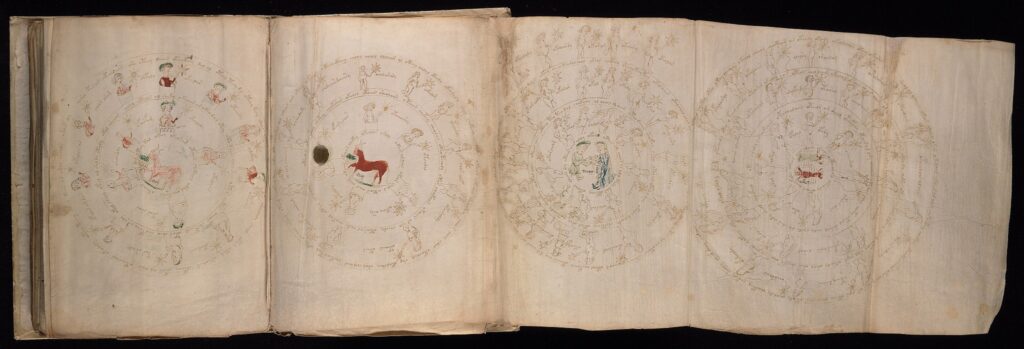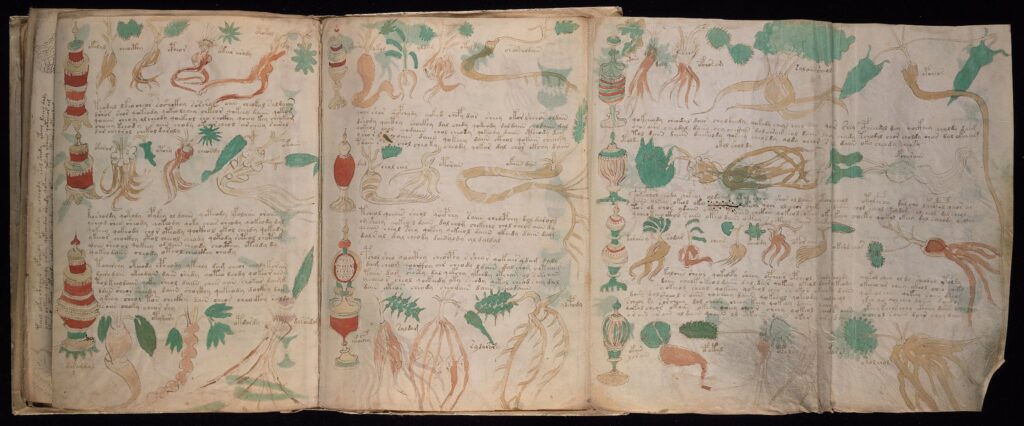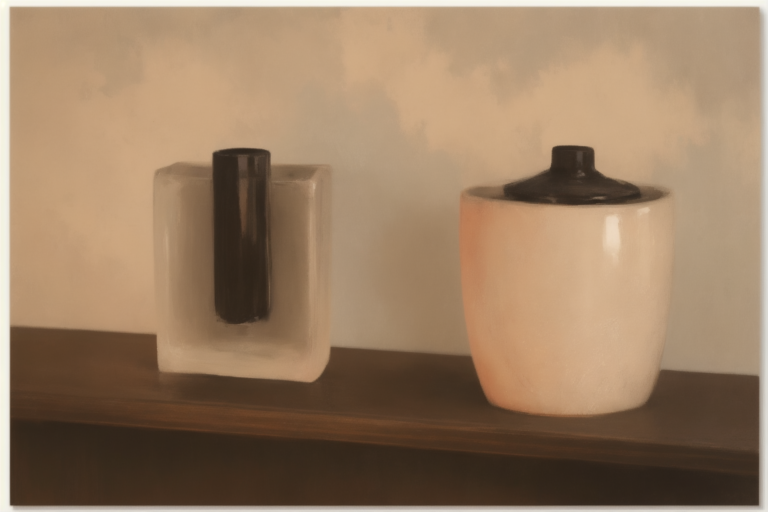Voynich Manuscript: AI-Generated Image
In Section 2: Content and Illustrations, there are images of the real book!
Introduction:
The Voynich Manuscript is a 15th-century cryptic codex written in an unknown script and language, which has baffled experts and captured the imagination of scholars, linguists, and the general public for centuries. The manuscript contains illustrations of plants, astronomical charts, and human figures, which have led some to speculate that it is a scientific or medical text. However, despite numerous attempts, no one has been able to decipher its meaning, making it one of the most intriguing and mysterious objects in the world.
1. History and Discovery:
The manuscript was first discovered in 1912 by Wilfrid Voynich, a Polish book dealer and collector, who purchased it from a Jesuit college in Italy. Although the book dates back to the 15th century, between 1404 and 1438. Voynich initially believed the manuscript to be the work of the 16th-century alchemist and philosopher Roger Bacon. However, subsequent expert examination revealed that the manuscript predates Bacon, and its origin and author remain a mystery.
The manuscript’s subsequent history is equally captivating. After its discovery by Voynich, the manuscript passed through the hands of various collectors, scholars, and cryptographers, who attempted to decipher its contents. The manuscript was acquired by the Beinecke Rare Book and Manuscript Library at Yale University in 1969, where it remains to this day. Throughout its history, the manuscript has been the subject of numerous theories regarding its origin and purpose. Some scholars have suggested that it is a hoax, created by a prankster or forger seeking to dupe unsuspecting collectors. Others have proposed more elaborate theories, suggesting that the manuscript contains hidden knowledge, alchemical secrets, or even extraterrestrial communication. There has been much discussion, but no clear consensus has been reached regarding the meaning of the manuscript. Some experts have suggested that the manuscript’s text is written in an unknown language or script, while others have proposed that it is a form of cryptography, designed to obscure its contents. The manuscript’s illustrations, which depict plants, astronomical charts, and human figures, have provided some clues, but no definitive answers.
As the Voynich Manuscript continues to baffle researchers, its history and discovery remain integral to the ongoing quest for understanding. The lack of a clear provenance, coupled with the ambiguous origins of the manuscript, contributes to the air of mystery that surrounds it. Theories regarding its creation and purpose only deepen the intrigue. Countless scholars and enthusiasts have devoted their lives to unraveling its mysteries.
2. Content and Illustrations:
The Voynich Manuscript is renowned not only for its mysterious text but also for its intriguing illustrations and diagrams. The manuscript contains a wealth of images, including detailed drawings of plants, elaborate astronomical charts, and enigmatic human figures. These illustrations have long puzzled scholars, who have sought to decipher their meaning and purpose.

One of the most prominent features of the manuscript is its plant illustrations. The manuscript contains more than 100 drawings of plants, many of which are depicted in extraordinary detail. The plants are often shown with their roots, stems, leaves, and flowers, and some are accompanied by captions. The vibrant and fantastical nature of these drawings has led some to suggest that the manuscript may be a compendium of herbal knowledge, intended for medicinal or alchemical purposes. Despite numerous attempts, no one has been able to identify these plants with certainty, leaving their true nature a mystery.

The astronomical charts in the book are equally puzzling. These charts depict various celestial bodies, including the sun, moon, and stars, as well as elaborate diagrams of constellations and zodiac signs. Some scholars have suggested that the charts represent an early form of astrology or astronomy, hinting at a connection to medieval beliefs about the influence of celestial bodies on earthly affairs, while others have proposed that they are merely decorative elements…yeah…sure.

The human figures in the Voynich Manuscript are another intriguing feature. These figures are depicted in various poses and settings, often surrounded by plants or astronomical symbols in surreal and peculiar scenes. The figures are drawn engaging in various activities, from bathing in surreal pools to interacting with strange, interconnected pipes or tubes. Some think that the figures represent mythological or allegorical figures, while others think that they are simply decorative elements…yup, you guessed it…again, probably they thought this for the plants too.

The illustrations also provide valuable insights into the cultural and historical context in which the manuscript was created. The plant drawings, for example, suggest that the author had a deep knowledge of botany, while the astronomical charts indicate an interest in celestial phenomena, offering a multifaceted glimpse into the intellectual pursuits of the manuscript’s creator. As for the human figures…well…the exact meaning and purpose of these figures remain unknown, or maybe that is just the information we are given.
3. Script and Language:
This ancient book consists of approximately 240 pages of handwritten text. The manuscript’s script is unlike any known language, with more than 30 characters, some of which have no known equivalent. The script is written from right to left, and many of the characters are interconnected, making it difficult to distinguish individual letters or words. Over the years, various cryptographers and linguists have attempted to crack the code of the Voynich Manuscript. They have proposed that the manuscript is written in a code based on Latin or Hebrew, another possibility is that it is a form of shorthand or stenography, a method of hiding messages within other text or images. However, none of these theories has been proven.
One of the most notable attempts to decipher the manuscript was made by William Friedman, a renowned cryptographer who worked for the US military during World War II. Friedman analyzed the manuscript for several years, but he was unable to make any significant progress. More recently, various computer algorithms and machine learning techniques have been applied to the manuscript, with limited success. Researchers have used statistical analysis to identify patterns in the manuscript’s text and also machine learning algorithms to identify possible correlations between the manuscript’s text and known languages.
Scholars think that the manuscript is a form of cryptography, designed to obscure its contents. Possibly a form of secret language or code, used by a group of people to communicate in secret.
To this day, despite many attempts, no one has been able to interpret the meaning of the manuscript.
4. Theories and Speculation:
Over the centuries, countless theories and speculations have emerged regarding the book’s origin, purpose, and meaning. From the mundane to the extraordinary, these theories have ranged from the plausible to the fantastical.
As we said before one of the theories is that the Voynich Manuscript is a hoax. This theory has emerged because some of the manuscript’s pages appear to be intentionally damaged or incomplete as if to obscure its meaning. However, the complexity and intricacy of the book’s script and language suggest that it is unlikely to be a mere hoax. Because of this, the more plausible explanation is that the book uses cryptography to hide its contents. Another and one of the most intriguing theories suggests that the manuscript contains hidden knowledge or even extraterrestrial communication.
My theory is that the author might be illustrating scenes from the world inside our planet Earth. And the language he is writing with is maybe the language of those human figures. But that’s just my imagination, as Albert Einstein said: Logic will get you from A to B. Imagination will take you everywhere!
Conclusion:
In conclusion, the Voynich Manuscript is a fascinating and enigmatic historical artifact that has puzzled and intrigued scholars and enthusiasts for centuries. Despite numerous attempts to decipher its meaning, the true nature and purpose of the manuscript remain a mystery, adding to its allure and mystique. Whether the manuscript contains hidden knowledge, secret messages, or simply the musings of an eccentric mind, its enduring allure will continue to captivate those who encounter it.
The manuscript’s unique script and language, combined with its intriguing illustrations, make it one of the most mysterious objects in the world. Its enigmatic nature has inspired countless theories and speculations, from the mundane to the extraordinary. From the idea that the manuscript is a hoax to the possibility that it contains hidden knowledge or even extraterrestrial communication. Its unique qualities and enigmatic nature have inspired countless books, documentaries, and even a Hollywood film.
In the end, the Voynich Manuscript is a testament to the human desire to unlock the mysteries of the unknown and the allure of the unknowable. As such, the book will continue to be a subject of fascination and intrigue for generations to come. Its enduring mystery and allure will continue to captivate and inspire those who encounter it, reminding us of the limitless possibilities of the human imagination.










